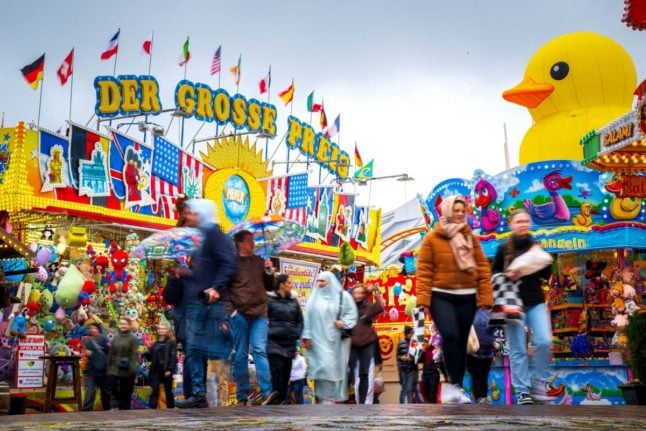Spring Festivals across Germany
Starting around Easter weekend, Germany’s myriad spring festivals bring bright colours and beer-fueled revelry to cities around the country.
Spring festivals come by many names in Germany – there’s the clearly named Frühlingsfest (spring fest) such as in Munich, or the Volksfest (people’s festival) like in Nuremberg, and then there are uniquely named local variations like Frankfurt’s Dippemess. But they all offer carnival rides, abundant food and drink, and an opportunity to see how German’s let loose – think Oktoberfest, but with a palpable spring theme.
This year both Dippemass in Frankfurt and Volksfest in Nuremberg begin in late March and continue until April 14th.
Munich’s Frühlingsfest will run from April 19th to May 5th. Stuttgart’s spring festival is on from April 20th to May 12th.
Readers in the north of the country may want to try Hamburg’s DOM running until April 21st this year.
Cherry blossom gazing
Delicate white and pink blossoms that appear only for a couple weeks in April, cherry blossoms are both a symbol of spring and object of fascination around the world, from the furthest reaches of East Asia to right here in Germany.
The early onset of warmer temperatures in Germany this year is causing cherry trees to bloom earlier than usual, but there should still be some blossoms on the trees during the previously scheduled cherry blossom festivals that take place in many German cities.
READ ALSO: Seven signs that spring has arrived in Germany
The city of Bonn’s old town, with its cherry tree covered streets, has become the go to spot for blossom gazing and photography in Germany. Early to mid-April tends to be the best time to visit, and this year the blossom-adorned streets will be closed to cars for three weekends starting from April 13th.
But if you don’t live close to Bonn you can find several locations around Germany where cherry blossoms are in full bloom here.

Music festivals begin
While the majority of Germany’s bigger music festivals are held in summer, there are quite a few in spring – with a few noteworthy music fests even happening in the coming month.
For fans of metal music, the 19th iteration of Ragnarök Festival will be held at Stadthalle Lichtenfels on April 4th to the 6th this year.
For something a little softer, Polimagie Festival in Dresden features indie, rock and pop artists from Germany, the UK, and Europe – from April 17th to 21st.
Alternatively, jazz and big band lovers are encouraged to check out the fourth Jazz Festival of the Deutsche Oper in Berlin. Several concerts will take place from the 17th to 22nd. Single tickets are around €20, and are found here.
International Women’s Film Fest in Dortmund and Cologne: April 16th to 21st
Germany’s largest forum for women in the film industry, the “Frauen Film Fest” aims to “strengthen the influence of women in all trades of the cinema industry: first and foremost directors, but also cinematographers, producers, screenwriters, composers, actors and more.”
It’s also an opportunity to see one of 95 films from 40 countries. Choose from screenings of short film collections or feature length films from debuting including those entered in the International Debut Feature Film Competition.
There are also workshops and discussions that allow attendees to meet some of the women behind the films.
Gallery Weekend Berlin – April 26th to 28th
Since 2005, Berlin galleries have presented exhibitions by emerging and established artists during this three day event.
The last gallery weekend included performances, screenings, sound pieces, readings, and installations. This year 55 galleries spread across Berlin’s central neighbourhoods will participate.
According to the event organisers, a handful of exciting new galleries will join the event this year including: Galerie Molitor, Noah Klink Galerie, Schiefe Zähne, Sweetwater and Heidi.
More information can be found at Gallery Weekend Berlin’s website.

Walpurgis Nacht
The origins of Walpurgis Night date back 1,000 years to pagan traditions in Germany, and is celebrated on the night of April 30th each year.
St. Walpurgis was honoured with a feast day on May 1st, and people gathered to dance the night before. It’s also considered to be the time when witches gather. The name “Walpurgis Nacht” was popularised by Goethe’s Faust in 1808.
Smaller villages in some regions in Germany, like the Harz mountains, celebrate Walpurgis Nacht with festivals. Bad Grund, for example, hosts festivities including open air theatre and dancing.
Walpurgis related celebrations can also be found in Germany’s bigger cities, such as Peaceful Walpurgis Night which is hosted in Berlin’s Mauerpark each year.
READ ALSO: Are you ready for Walpurgisnacht, Germany’s night of witches?



 Please whitelist us to continue reading.
Please whitelist us to continue reading.
Member comments